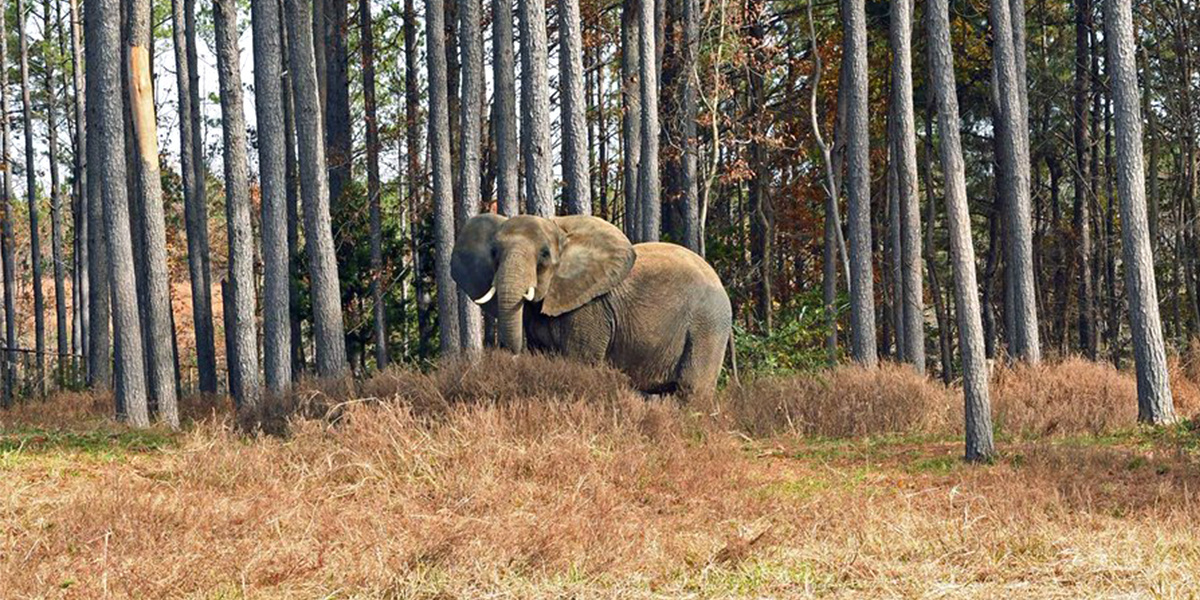
‘Saddest Elephant in the World’ Wins Freedom, Care After Decades of Chains and Abuse

By Katherine Sullivan
Nosey the elephant is getting the fairytale ending she so rightfully deserves.
Last week, Lawrence County District Court Judge Terry declared that Nosey the elephant won’t be returned to the people who left her chained and swaying back and forth in her own waste with urinary tract, skin and roundworm infections as well as painful osteoarthritis and signs of dehydration and malnutrition.
BREAKING VICTORY: After decades of being chained, neglected, and forced to give people rides, Nosey the elephant will NOT be going back to her abusers. https://t.co/e58X63E3jf pic.twitter.com/taQAD0WJ9r
— PETA (@peta) January 22, 2018
Our campaign for Nosey started in 2004, when a whistleblower reported that she was being routinely abused with bullhooks and electric prods. Over the years, we persuaded venues not to host performances with the suffering elephant, persuaded authorities to bar Hugo Liebel’s elephant act, worked with elephant experts, engaged members of Congress and obtained celebrity support in favor of her release to an accredited sanctuary where her needs could be met properly.
We thank local authorities for initiating this course of events and everyone who worked to keep Nosey away from Liebel—the man who used chains and intimidation in order to force her to give rides for decades.
The Road to Justice Was a Long One
Prior to Nosey’s seizure, Liebel had been cited by the U.S. Department of Agriculture for nearly 200 animal welfare violations. Most of these citations were related to his mistreatment of Nosey, including repeatedly chaining her so tightly she could barely move and denying her necessary veterinary care. This cruelty had been occurring for decades.
On Nov. 8, Lawrence County District Court Judge Angela Terry issued a writ of seizure after Animal Control Officer Kimberly Carpenter—who could be described as Nosey’s guardian angel—found the elephant confined to a trailer at a truck-repair shop where the Liebels were reportedly having their brakes fixed. She was standing in feces and without proper shelter. The trailer that she was confined to was so small that Nosey couldn’t take a step or turn around.
On Nov. 9, Judge Terry held a hearing to determine whether the seizure should stay in place. After the hearing, she ordered animal control to “make arrangements as necessary for the housing and care” of Nosey. That night, she was transported to the Elephant Sanctuary in Tennessee.
African #elephant #Nosey arrived safely at The Elephant Sanctuary in Tennessee late Thursday night. https://t.co/a4FpooSLiC pic.twitter.com/eDAt71wTIi
— The Elephant Sanctuary (@ElephantsTN) November 10, 2017
At the sanctuary, Nosey was given the care and protection she deserved all along. When she arrived, the staff was waiting for her with welcome presents: fresh produce, bamboo and banana leaves. The veterinary and husbandry teams carefully monitored her throughout the night and reported that Nosey was calm and already showing interest in her new surroundings at the lush green refuge. The Elephant Sanctuary has continued to provide updates about Nosey on its website, as well as through its Facebook, Instagram and Twitter accounts.
On Dec. 15, a trial was held to determine whether the seizure should be made permanent. Key testimony came from expert witness Lydia Young, associate veterinarian at the Elephant Sanctuary. She testified that Nosey had arrived at the sanctuary showing signs of dehydration and that she had been underfed.
She also had multiple infections. Nosey was suffering from a painful urinary tract infection, a roundworm infection (caused by ingesting fecal matter) and a chronic bacterial infection from her severely dry, cracked and overgrown skin. She was stiff and sore, and her left hind leg was swollen.
The sanctuary was able to perform radiographs on the leg, which confirmed that she’s suffering from osteoarthritis. According to Dr. Young, Nosey requires daily veterinary care for her conditions. Her skin will take months or years to improve, and osteoarthritis is an incurable, chronic disease that requires pain management and species-appropriate exercise.
Although the trial lasted more than 10 hours, the judge didn’t rule on the case at that time.
Another victory was achieved the following day, when Liebel and his wife Franciszka were arrested and charged with cruelty to animals in relation to their treatment of Nosey.
Good news! Hugo and Franciszka Liebel have been charged with cruelty to animals in relation to Nosey the elephant. pic.twitter.com/vvxnFE5w4o
— PETA (@peta) December 16, 2017
We applaud local authorities, including ACO Carpenter and Assistant District Attorney Callie Waldrep, for standing up to cruelty and making the best possible case for this elephant. At the Elephant Sanctuary, she’ll continue to receive round-the-clock veterinary care. Although Liebel’s attorney has threatened to appeal, we will continue to push to keep Nosey right where she is.
Katherine Sullivan is an online content producer at People for the Ethical Treatment of Animals.
Reposted with permission from our media associate AlterNet.

 233k
233k  41k
41k  Subscribe
Subscribe 